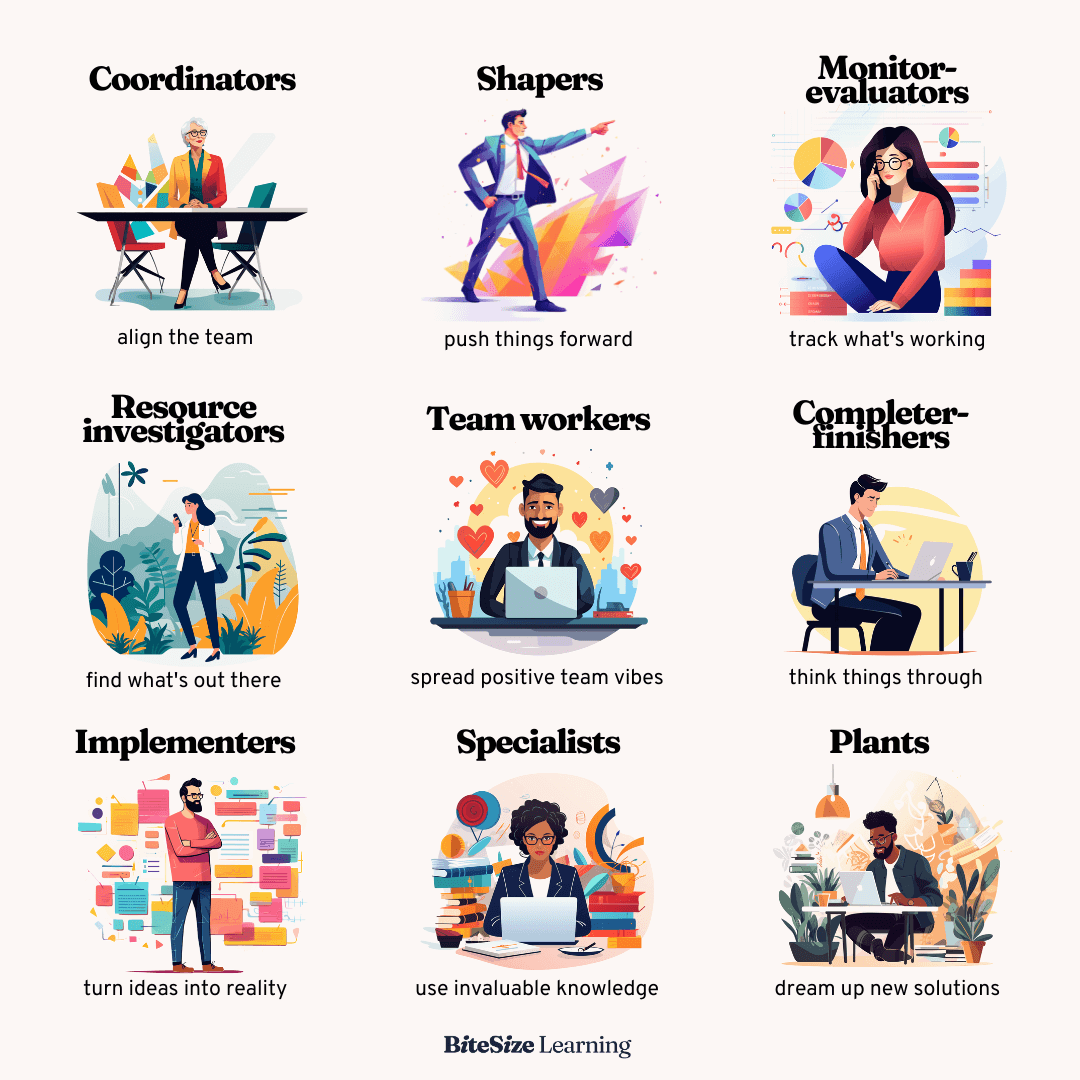Belbin team roles, explained
Library → Models and frameworks → Belbin team roles
Dr. Meredith Belbin's pioneering concept of team roles reveals the secret of optimising team performance.
Belbin’s team roles theory highlights two paramount attributes each individual brings to a team. First off, their competencies - the specialist knowledge, qualifications, and experience that primarily informed their recruitment. This includes a vast array of skills, from IT expertise to an understanding of production methodologies. This is what we call the 'task focus', the primary force behind accomplishing the job at hand.
However, there's a second element that's just as vital - the 'team focus'. This relates to how an individual collaborates within a group and boosts its overall efficacy. It's not just about getting the job done; it's about the process and the dynamics of how it's achieved.
In his practical research at Henley Management Centre, Dr. Belbin analysed both successful and unsuccessful teams participating in management games. His findings unveiled nine distinctive behavioural clusters, or team roles. Each role reveals a unique approach to successful teamwork and interpersonal relations, shaping the way an individual contributes to and behaves within a team.
Do any of these characters sound familiar? Which do you most resemble?
Dr. Belbin discovered that teams displaying a balance of these roles enjoyed the highest probability of fostering fully effective working relationships. His model empowers a team to dissect its strengths and weaknesses in terms of team roles. By doing so, the team can strategically leverage its strengths and curb the impact of its weaknesses.
Much like assembling an all-star football squad, you'd seek diverse characteristics and skills. A single excellent goalkeeper is desirable, but a team of 11 goalkeepers is counterproductive. Similarly, in the professoinal world, a balanced mix of complementary styles and preferences often trumps a homogenous group of similar personalities.
"Strength lies in differences, not similarities."
– Stephen Covey
A team that solely comprises imaginative, creative geniuses might fail to convert ideas into practical reality. On the other hand, a team composed exclusively of meticulous, detail-oriented individuals might lack the creativity to innovate, leading to stagnation.
Belbin's nine team roles, each with its strengths, allowable weaknesses, and intolerable weaknesses, provide a comprehensive framework for understanding team dynamics. As a team leader, the challenge lies in recognising these traits and leveraging them effectively. It's crucial to differentiate between 'allowable' and 'intolerable' weaknesses, with the former potentially serving as a strength to be harnessed and the latter requiring proactive management to avoid harmful behaviour.
Let’s take a look at the nine team roles, followed by some insights into how you can apply the model to your own. team.
The nine Belbin team roles
1) Co-ordinators
Team alignment is a co-ordinator priority.
The Co-ordinator is the team's confident captain.
Co-ordinators are drawn towards leadership vacuums: they focus on getting everyone on the same page. They become the team's supportive guide, directing the flow of effort and ensuring that everyone's talents are utilized to their fullest potential.
They have a strong sense of purpose, and are adept at making sure everyone feels valued and heard.
Their strategic perspective allows them to see the big picture, enabling the team to move towards their common goals smoothly and efficiently.
However, team members in more ‘hands-on’ roles may not always take their contribution seriously, suspecting them of avoiding the actual work. Nevertheless, co-ordinators are especially valuable in teams with independent operators like Plants, Resource Investigators and Specialists, who might otherwise forget to communicate.
✅ Co-ordinator strengths: Mature, confident, a good chairperson, clarifies goals, promotes decision-making, delegates well. An open-minded presence with a natural appreciation for what everyone has to offer.
😬 Co-ordinator weaknesses: Can sometimes be seen as manipulative. They might avoid taking personal responsibility for tasks, in favour of always co-ordinating the efforts of others. Tends to tolerate a so-so consensus over taking a bold decision.
⚠️ Ensure Co-ordinators don’t: take all the credit for the effort of the team. Encourage them to lead by example, get stuck in and serve others.
2) Shapers
‘Let’s get on with it!’ is the shaper mantra.
The Shaper is the team's dynamic motivator.
They might occasionally come off as challenging, but it's only because they're passionate about driving the team towards success. Their ambition is infectious, instigating action where it's needed most, and they excel in turning ideas into action, providing the necessary spark to set things in motion.
Closely related to the ‘driver’ social style, Shapers strike many as hard-charging. And they’re intrinsically sceptical about the value of reflection, patience and caution – for the shaper, the time is always now!
✅ Shaper strengths: Challenging, dynamic, thrives on pressure. Open to ideas and insights while focusing on turning them into concrete plans or action points. The drive and courage to overcome obstacles. A forceful personality that can overcome external opposition outside the team.
😬 Shaper weaknesses: Prone to frustration and irritation. Not overly concerned with other people’s feelings. The same forceful personality can steamroll opposition within the team.
⚠️ Ensure Shapers don’t: Cross the line into bullying, or break important rules to get stuff done fast.
3) Completer-finishers
The i dotting, t-crossing superhero of the team.
The Completer-Finisher is the team's meticulous perfectionist.
They are dedicated to making sure every task is completed with maximal quality. Their high standards and keen eye for detail ensure that nothing is overlooked, and their commitment to finishing what's started provides the team with the assurance that every project will be thoroughly scrutinised.
The view that a piece of work is simply ‘good enough for now’, or that a cheeky shortcut is ‘no big deal’ does not sit well the completer-finisher. Others may find the Completer’s stickler tendencies a little rigid, while completers may avoid letting others have the final say because they don’t trust anyone else to treat the outcome with sufficient seriousness.
Completer-finishers are a must for teams with with Plants and Resource Investigators, who are alas much better at starting things than finishing. They share a cautious outlook with their double-barrelled cousins, the Monitor-Evaluators.
They can collaborate very effectively with Implementers (who work to get deliverables to ‘acceptable’ by the most efficient route possible), as long as they respect each other’s roles (as in a writer/editor dynamic) rather than judge each other (‘did a half-baked job!’ / ‘can’t let anything go!’)
✅ Completer-finisher strengths: Painstaking, conscientious, and self-disciplined. Actively searches out errors and omissions. Keeps the team accountable and standards high. Delivers on time.
😬 Completer-finisher weaknesses: Inclined to worry unduly. Reluctant to delegate. Can find others to be slapdash and unreliable.
⚠️ Ensure Completer-finishers don’t: Become obsessive, or block others from performing tasks.
4) Team workers
The Teamworker is the team's warm heart.
They value harmony and social cohesion, ensuring that everyone feels included and comfortable. Their empathetic nature allows them to understand and help resolve personal issues within the team, promoting a positive and supportive environment. Their ability to foster unity makes them crucial to maintaining team morale and productivity.
However, Team Workers are conflict-averse, and can avoid difficult decisions or offering candid feedback that might hurt feelings. Spells of tension or discord weigh heavily on the mind of the Team Worker.
✅ Team worker strengths: Co-operative, mild, perceptive and diplomatic. Listens, builds, averts friction.
😬 Team worker weaknesses: Indecisive on crucial issues.
⚠️ Ensure Team Workers don’t: Avoid taking difficult decisions.
5) Plants
‘Nobody panic, but I’ve got a wild idea… yes, another one.’
The plant is an essential creative force on any team.
With a remarkable ability to think outside the box, they're continually generating new and innovative ideas. They have a unique perspective that allows them to solve complex problems in imaginative ways. Their mind is a garden where fresh thoughts and groundbreaking solutions grow, providing invaluable resources for their team.
Their aptitude for bringing in knowledge and perspectives from outside the status quo means their attention is not always on the core team mission. They may not always do a great job of communicating with others, and they find the practical impediments to implementing ideas frustrating.
✅ Plant strengths: Creative, imaginative, unorthodox, solves difficult problems.
😬 Plant weaknesses: Tends not to enjoy the messy compromises that come with putting ideas into practice. Unlikely to communicate frequently. Suspicious of protocols, systems and traditions.
⚠️ Ensure Plants don’t: Hoard 'ownership' of ideas by keeping plans pristine at the ‘drawing board’ phase, when co-operation with others would yield better results.
6) Resource investigators
‘That’s wild: I know a guy who knows a guy who is just the guy we need.’
The Resource Investigator is the team's explorer, always eager to delve into uncharted territories and explore new possibilities.
They have a knack for establishing contacts and networking, making them invaluable in gathering external information and resources. Their vibrant energy and enthusiasm make them a driving force that helps propel the team forward.
Sometimes, their love for novelty and discovery makes them a distractible force. So they’re at the most powerful when teamed up with get-it-done types Implementers and Completer-finishers.
✅ Resource investigator strengths: Extrovert, enthusiastic, communicative. They explore opportunities and develop contacts, searching outside the team for solutions. Highly motivated by a sense of challenge – an adaptable personality that embraces change.
😬 Resource investigator weaknesses: Over-optimistic. Rapidly loses interest once initial enthusiasm has passed. Slows down without time pressure. Focused on expanding the ‘possible’ (what we could do) rather than the ‘practical’ (what we ‘can’ do) or desirable (what we ‘should’ do.)
⚠️ Ensure Resource Investigators don’t: Let people down by forgetting to follow up.
7) Implementers
‘But how are we actually gonna do this, folks?’
The Implementer is the team's powerful engine.
They are dedicated and disciplined, translating the team's plans into manageable tasks, and ensuring that processes work well. They are capable and efficient, with an eye for detail that helps them turn abstract concepts into reality. Their steadfast approach provides the team with a steady and reliable source of progress.
Wooly proposals where due thought has not been given to the details of implementation are naturally a bugbear to this practical role. A hands-on hero, they sometimes see themselves as ‘the only one doing any real work around here.’
It helps to clearly delineate when ideas are at the ‘dream’ stage (for instance, in a brainstorm) so Implementers do not immediately feel the need to start getting into the practical details. However, they are a valuable and down-to-earth voice during the ‘winnowing’ stage, when it’s time to prioritise ideas based on feasibility.
✅ Implementer strengths: Disciplined, reliable, conservative and efficient. Turns ideas into practical actions. Implementers take a systematic approach, usually making their work visible and legible to others – for instance, they’re able to offer a clear and candid assessment of progress.
😬 Implementer allowable weaknesses: Somewhat inflexible. Sometimes slow to embrace new possibilities, preferring orthodox approaches that have been proven to work. Their primary focus is on delivering agreed outcomes rather than pursuing anything ‘above and beyond.’
⚠️ Make sure Implementers don’t: Obstruct change by vetoing early ideas or refusing to experiment.
8) Monitor-evaluators
‘Let’s make a pivot table about this, then we’ll talk.’
The Monitor Evaluator is the team's careful watchdog.
Their ability to think critically is a crucial asset when it comes to making informed decisions. They have a remarkable ability to weigh pros and cons, discern patterns, and analyze data.
Their calm, rational perspective helps prevent hasty mistakes, ensuring that the team moves forward on a solid foundation of clear, logical reasoning.
Admittedly, Monitor-Evaluators can be seen as cool customers: they might not share team excitement and take a sceptical view of unquantifiable hunches or ideas. But a quiet word of praise from one of these judicious types is the low-key equivalent of a Hollywood Handshake!
✅ Monitor-evaluator strengths: Sober, strategic and discerning. Sees all options, anticipates problems, detects threats early and judges accurately. Helpful at avoiding worst-case scenarios. Not afraid to pour cool water on impractical ideas. Has the courage to take hard-headed, data-driven decisions even if they cause a few bruised feelings.
😬 Monitor-evaluator weaknesses: Lacks the passion to inspire others - on the contrary, they would prefer others calm down a bit. They aim away from disaster, rather than towards glory, and can come across as a ‘downer’ during moments of triumph. Not keen on nurturing hunches or intuitions, or taking ‘the human factor’ into account.
⚠️ Ensure Monitor-Evaluators don’t: project ceaseless cynicism, without regard to facts or logic. Aim for a bit more Yoda, and a bit less Eeyore.
9) Specialists
The Specialist is the team's dedicated expert.
The ninth of the Belbin team roles, their passion and commitment to their field of expertise makes the Specialist an invaluable resource. They continuously strive to expand their knowledge, contributing depth to the team. Their dedication is inspiring, and their expert advice can often be the key to overcoming challenging situations.
However, they are least likely to engage with the overall ‘team mission’ on the whole – they are only there to make sure their unique bit goes well, and that’s it. They may be too comfortable with their role as ‘expert in X’, and unwilling to consider feedback from the rest of the team.
✅ Specialist strengths: Single-minded, self-starting, dedicated. Provides knowledge and skills in rare supply.
😬 Specialist weaknesses: Contributes only on a narrow front. Dwells on technicalities. Overlooks the ‘big picture’. Acquires knowledge for its own sake.
⚠️ Ensure Specialists don’t: Ignore factors outside own area of competence.
How understanding Belbin team roles can help you manage your team
Consider team focus during recruitment, not just task
When hiring, don’t look only for expertise – consider the ‘team focus’ someone brings to the role. And you don’t need to execute a ‘straight swap’ for the previous person! Perhaps a replacement hire offers an opportunity to bring in a natural Completer-Finisher, and relieve your Resource Investigator from some minutiae. Capitalise on recruitment to fill the gaps in your team, searching for individuals who personify the missing team roles.
Compensate for missing team roles
Take note of gaps in your team’s role profile and find ways to manifest the magic in whoever’s missing. The key is flexibility and adaptability in leveraging the strengths you have while addressing the gaps that exist.
Processes: Find ways of working to support the ‘missing’ behaviour, especially as it doesn’t come naturally. For example:
Missing a Monitor-Evaluator? Set up dashboards and checklists that make it really easy to track progress.
No Plants in the pot? Make sure you carve out time for the team to brainstorm and dream up new ideas.
No natural Co-ordinator? Set automatic rhythms for communication and decision-making rather than expecting alignment to naturally emerge.
Bring in people from outside the team:
If the team reports into someone, get them to focus on playing a missing role. For instance, a team without a Shaper might require decisive decision-making from above, while a team without a Complete-Finisher might need more stringent quality control.
Bring in experts: get Shaper or Co-ordinator types to drop in and run workshops. Fill independent-minded roles like Plants and Resource Investigators with outside contributors.
Let people work their way
If your team is a social bunch, brimming with Resource Investigators and Team Workers, your modus operandi should be steeped in collaboration. Encourage a work environment rich with discussion, shared projects, and collective activities to maximise their potential. On the flip side, if your team consists of independent spirits like Completer-Finishers, Plants, and Monitor Evaluators, grant them the freedom to work autonomously.
Let the most fitting individual spearhead the project
Leadership isn't necessarily about seniority. You might find an Implementer taking charge, while a more senior Shaper or Monitor Evaluator oversees the project. Likewise, different roles may come to the fore at different times: Monitor-Evaluators might manage major quarterly progress reviews, Completer-Finishers have the final sign-off during a deadline crunch, while Team Workers lead daily check-ins;
Fill the gaps in your team through strategic role assignment.
Roles are fluid depending on the project and the team
Most of us are capable of filling multiple roles.
Necessity is one reason for adaptability. Even if you put a whole group of natural Monitor-Evaluator types in a room, eventually someone feels the need to Shape, Co-ordinate or Implement, otherwise there will be no activity to actually monitor.
So, strive to discover team members’ potential secondary styles – after all, this might be their primary style in a different context! Then, see how you can make space to bring these alternate strengths to the fore, adding another dimension to their workplace contribution. These opportunities can be a highly motivating addition, and stops people feeling pigeon-holed.
For more information about Belbin, visit belbin.com.











![[Guide] Handling conflict at work: what good managers do differently](https://images.squarespace-cdn.com/content/v1/6348398d9d21fd6277c64f96/1764074828110-OAKDWQ3PJ3E0VQ4BAE84/blog+images+June+2025+%2820%29.png)




